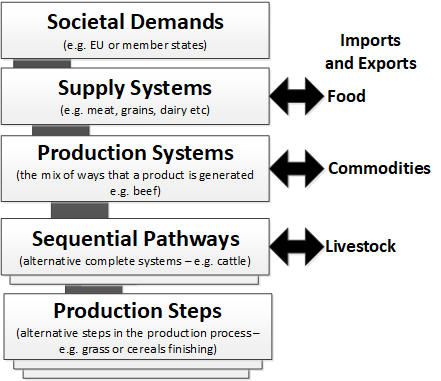In terms of systems, four functionally distinctive levels have been considered with these four levels set in the context of Societal Demand (Figure 5). While specific societal metabolic analyses of the nature of demand and its implications in terms of nutrition, social practice and health are possible [3], in this case the resources available to the researchers mean that societal demand was treated as an exogenous driver. The four levels considered are:
Supply Systems that consider how demand within a society (and potentially elsewhere) is met through a mixture of local production and trade in food.
Production Systems that represent the mix of ways in which agricultural production is carried out – in this analysis, production systems are represented by farm types (14) that are classified based on the value of their outputs. Production systems consider the aggregate outcomes of groups of farm businesses and this the level on which policy acts most directly through for example subsidy and regulation. Trade affects production systems through the import or export of agricultural commodities most notably livestock feeds.
Within Production Systems are Sequential Pathways and Production Steps. These levels are more specific representations of how individual enterprises within farm businesses are conducted. Here the diversity of management practices (with their varying consequences for productivity or environmental impacts) can be assessed. Within this deliverable the results are mainly concerned with outcomes at the Production Systems level, but the underlying data would allow study of particular livestock systems or individual crops as examples of sequential pathways and production steps.
